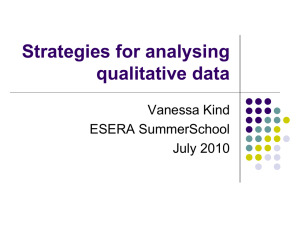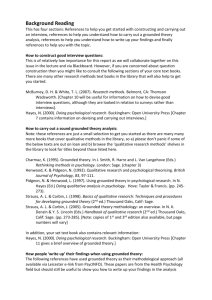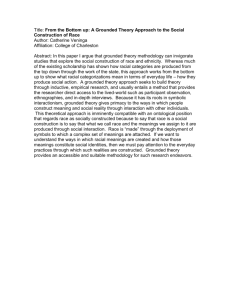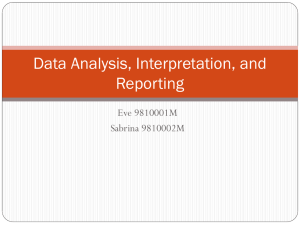A Grounded Exploration of Sales and Distribution Channel
advertisement
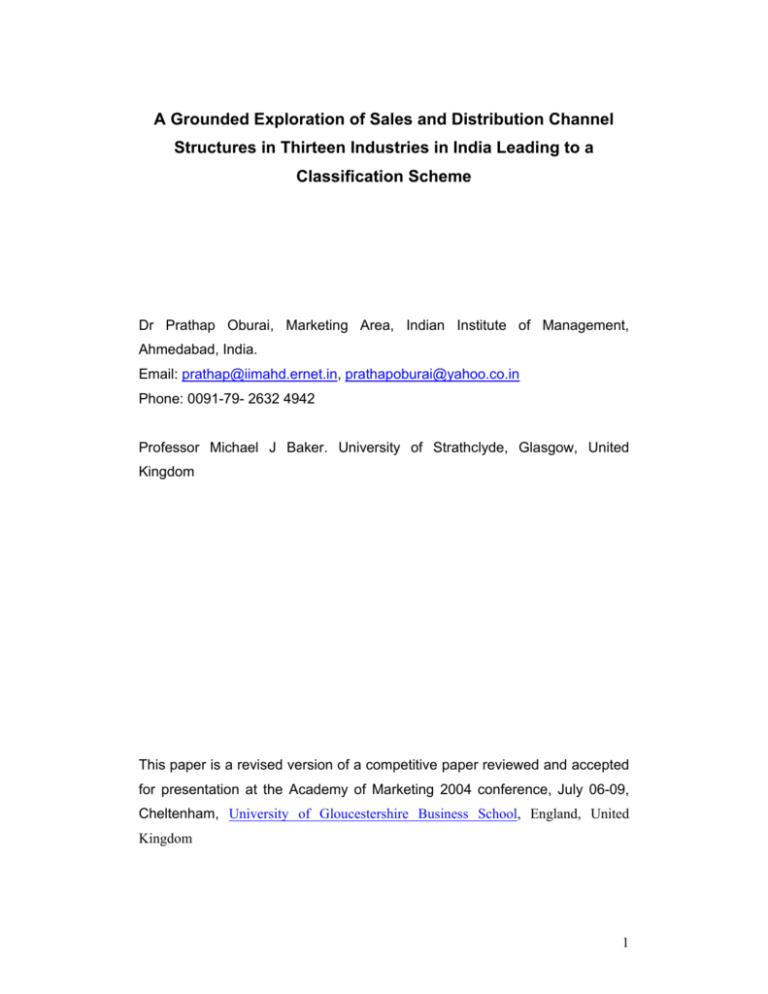
A Grounded Exploration of Sales and Distribution Channel Structures in Thirteen Industries in India Leading to a Classification Scheme Dr Prathap Oburai, Marketing Area, Indian Institute of Management, Ahmedabad, India. Email: prathap@iimahd.ernet.in, prathapoburai@yahoo.co.in Phone: 0091-79- 2632 4942 Professor Michael J Baker. University of Strathclyde, Glasgow, United Kingdom This paper is a revised version of a competitive paper reviewed and accepted for presentation at the Academy of Marketing 2004 conference, July 06-09, Cheltenham, University of Gloucestershire Business School, England, United Kingdom 1 A Grounded Exploration of Sales and Distribution Channel Structures in Thirteen Industries in India Leading to a Classification Scheme Abstract Innovation is a fundamental virtue of marketing. In this paper, a case is made to promote the use of innovative and novel combinations of research methodologies to derive new insights of business phenomena. This study is an attempt to understand and explain the sales and distribution channel structures in thirteen different industries in India. The investigation adopted a mix of case research and grounded theoretic research methodologies in exploring the subject under scrutiny. The study offers a classification scheme for grouping marketing channels into homogenous clusters based on similarity/dissimilarity using multivariate multidimensional mapping techniques. This scheme offers to explain the variety found in structures and suggests alternative channel possibilities. Such a scheme can be used in formulating marketing strategies and in deciding upon operational issues as well. While the main setting of the reported findings is Indian, the findings may prove to be useful beyond the national setting. Usual disclaimers associated with qualitative research methodology (Gummesson 1988) apply in this case concerning the generalisability and validity of the findings. This paper’s contribution is not as much in offering a schema as it is in suggesting an analytical plan/process that helps in visualising structures and associated strategies de novo. Key words: India Marketing Channels Marketing Strategy Relationship Marketing Research Methodology Sales and Distribution 2 Introduction This paper investigates the sales and distribution channel structures in thirteen different industries in India in an attempt to explore and explain the similarities and differences found in the varied set of industries. Marketing textbooks that deal with channels do not offer much guidance in this regard (Bowersox and Copper 1992, Coughlan et. al. 2002 Pelton et al. 2002 Rosenbloom 2001). These texts discuss functions and flows in very general terms, and more often than not focus on a single industry/sector. Not only do we find that the focus is narrow, but the organisation of texts is also an issue with chapters organised around different sectors. An example would be a chapter that focuses on retailing, industrial marketing or consumer goods channels. This treatment in our opinion does not recognise fully the similarities and differences that one finds across sectors in marketing channels. A thorough identification and recognition of these commonalties or lack thereof may prove helpful to businesses in making strategic and operational decisions concerning leveraging existing channels to their “fullest potential” by adding or deleting products and services. They may also decide to modify channels to suit their product and service portfolios. Our study offers a classification scheme using case research methodology (Oburai and Baker 1999a; Oburai and Baker 1999b), grounded theory approach (Glaser 1998), and modelling techniques. We employ case and grounded research in a descriptive way in data collection and organisation, and modelling for analysing the rich and varied data obtained. Though, the mix of methodologies employed makes the process rather idiosyncratic, it is hoped that researchers feel encouraged to adopt hybrid and varied methodologies in innovative and novel ways in their theory generating attempts. Methodology and the organisation of the paper Although the authors have a reasonably good understanding of the relevant literature, it was decided not to undertake formally an extensive literature review to abide by the spirit of grounded theoretic methodology (Glaser and Strauss 1967). This approach advocates building theories and explanations from empirical observation uncontaminated by premeditations or 3 preconceived views of the world as captured in theoretical works. Validity of theoretical frameworks, typologies or explanations arrived at after employing grounded research is rigorously ensured by comparing and contrasting with existing theories and frameworks. Literature review phase is not at the beginning of a research project but forms an integral part of the verification and validation phase (which is usually one of last few phases) in a grounded research method. This method is advocated and employed extensively by many management and other social science scholars. In the marketing field, the use of this strand of methodologies is growing and has found several strong advocates (e.g. Professors Gummesson and Lowe). We also take note of Brownlie and Saren’s (1997) suggestion that methodological pluralism is essential to understanding marketing as it exists in practice and to be able to portray an accurate picture of it. They urge marketing researchers to ‘move beyond naive literal interpretations of interview transcripts as an analytical strategy (p.158).’ The “pure” grounded theory approach may be an ideal, for all researchers have some degree of understating of the phenomenon that they choose to investigate. The current endeavour is not the most rigorous in its adherence to the principles of grounded theoretic research methodologies; however, we believe we have taken adequate care to abide by the spirit and approach intrinsic to the method. Grounded theory method and case research method are complementary and when employed in combination with the power that modern modelling techniques and associated software afford can lead to new insights. Elsewhere, it was argued that the main weakness of qualitative research methodologies is the ostensibly idiosyncratic and hence perceptibly subjective nature of the research process phases of data generation, analysis and interpretation. Bias is supposedly the inherent and all-pervasive infiltrator of qualitative research attempts, and lack of inter-subjective agreement or reliability a significant stumbling block. To quote from Oburai and Baker (1999b): Qualitative methods yield data that are ‘rich, full, earthy, holistic, “real”; their face validity seems unimpeachable; they preserve chronological flow where that is important, and suffer minimally from retrospective distortion… Furthermore their collection requires minimal front-end instrumentation (Miles 1979 p.590).’ While the attractions are many, Miles also notes that ‘Qualitative data tend to 4 overload the researcher badly at almost every point: the sheer range of phenomena to be observed, the recorded volume of notes, the time required for write-up, coding, and analysis can all be overwhelming. But the most serious and central difficulty in the use of qualitative data is that methods of analysis are not well formulated’(Miles 1979 p.590). In using the combination of case research, grounded theoretic approach and modelling techniques, we hope to lend rigor to the application of methodological pluralism, data analysis and inference drawing process (Brownlie and Saren 1997; Yin 1994). This paper hopes to make contributions by offering a classification scheme or typology of distribution channels that enables marketers in mapping channels of different sectors in a two dimensional space. Such a map can help marketers optimise channel and product portfolios. It may be noted that increasing the number of dimensions is not constrained in anyway, and simplicity and the interest of interpretation is what guided us in choosing a two dimensional solution. The setting of the data for this paper is in India. This study is exploratory and qualitative. A brief mention of the process adopted may be in order to help readers in understanding both the paper and the research process employed in arriving at the reported findings and conclusions. Using both field studies that involved in depth interviewing of managers and published sources (e.g. periodicals, annual reports etc.), descriptive case studies were first written up for 13 firms in different industries. A minimum of two different managers were interviewed for each of the organisations contacted. Several of the managers were also contacted subsequently for clarifications and further information obtained as and when needed. This first phase was guided by a protocol that established guidelines to ensure uniformity in coverage and depth. These extensive long accounts were later turned into short précis that contained the essence and substance of the earlier mentioned case studies. These short summaries are presented in “Section One” of this paper below. These accounts still have a lot of contextual detail that is difficult to absorb in a first read. Readers may want to quickly read through these to get an overall picture before proceeding to the later sections. The next section “Section Two” is a summary of the contents of Section One. This is presented in a tabular form and has ten key variables and our 5 assessment of the degree of importance for each of the 10 variables for each of the 13 chosen industries. These ten variables fall into two broad categories namely industry related ones and channel member related ones. This table was subjected to multivariate analysis using multidimensional mapping analysis (MDS). The resulting two dimensional solution that maps the 13 different industry channels is presented in “Section Three” and is followed by a discussion of the findings and implications thereof. Finally, we outline several limitations of the present study and also offer directions for future research. Section One: Detailed summaries of channel structures in 13 different industries in India The following is a summary of 13 different industries’ sales and distribution channel structures. The aim here is on capturing the channel structure of the industry as a whole. In a few cases the write up captures the dominant firm’s channel structure. This is done to paint a rich picture and to enhance readability. Our view is that the chosen firms’ structures represent industry structures. The 13 industries are Cars, Paints, Newspaper, Credit Cards, Tobacco, Cell Phones, Footwear, Motorbikes, Ice Cream, Chocolate, Fertilisers, Toothpaste, and Detergents & Shampoos. The data used for the following write-up is subject to change, and hence can be used only as an approximation. Readers may like to refer to more current information for upto-date and exact data. 1. Passenger Cars: This sector is characterised by high unit value, high margins and high competition. Given the high investments that dealers are required to make upfront and also towards working capital, margins can easily get offset. Sales are seasonal. Yearend sales are low as car models and year of manufacture affect resale values. Organisations also tend to make use of depreciation allowances by purchasing before the end of financial year and also to meet budgetary provisions and expenditure. Manufacturer-dealer relationships, given the fact that not many firms need more than 200 dealers to cover the 6 nation, have the potential to develop into strong partnerships. Low volumes cannot sustain a large number of dealers. This channel is a simple chain in terms of flows and functions. Rural markets may not be able to support dedicated local dealerships. 2. Household Paints: The paints business is marked by high seasonality. Festive seasons are the peak seasons. The number of dealers in a locality is an important parameter in this business as a high dealer concentration can offset the sales volumes. Lighter colours are fast moving. Working capital requirements are moderately high. In a market dominated by ICI, Berger and Asian Paints, it appears that several innovations have made the logistics component efficient. Some firms have even outsourced the entire function. This allows scope for retailer to company interaction and collaboration in a sector so far not known for close cooperative relations between manufacturers and retailers. 3. Newspaper Industry: Newspapers are sold in India at prices as low as Rs.2/- (Indian national Rupees) or US$ 0.05 (1US$ is Rupees 50). Advertising revenue is said to be the main source of income for businesses in this sector. Margins to distributors, wholesalers, retailers, and hawkers account for as much as 50% of sale prices. This business requires “direct-to-consumer’s-door-delivery”. Timely delivery is essential, and unsold copies have little value. Firms battle for circulation figures which help in raising advertising revenues. Movement of goods is a key sales and distribution function. Main cities and towns are easy to serve when production (local editions) is local. The only precondition is minimum volumes or circulation levels. 4. Credit Card Industry: Given the low penetration levels and cash culture, this sector’s fortunes are tied to the burgeoning middle class size and spending habits. A number of banks who have tie ups with either Visa and/or MasterCard or offer own labels compete aggressively to enrol members. Using bank branches as well as direct sales associates (DSAs) for marketing credit cards to existing bank 7 customers and others through targeted databases are the preferred strategies. One estimate puts the number of credit card users at seven million. Credit ownership does not however translate into usage. Owning multiple cards only makes this market even more problematic. Defaulting on credit card payments used to be a significant issue, but not any more so. The increased scrutiny of applications to verify creditworthiness and other factors appears to have driven the industry to focus on the upper end of the market. Increasing awareness of credit cards, usage options, special offers, and retaining and adding to customer base are the focus areas for businesses in this sector. A number of banks appear to be using credit card products for cross selling to existing bank customers rather than to operate as credit card marketing specialists. 5. Tobacco Industry: The cigarette industry is dominated BAT’s subsidiary in India. This firm reaches 2 million retailers using factories-depots-branches-wholesalersretailers chain. Wholesalers employ own salesmen and supply products to retailers. The demand and consumption is not seasonal and almost all sales are made on cash basis. This zero credit policy ensures that the firm has no collection problems and hence no defaults in payments from the channel members. High brand equity and products covering a range of price points and customer segments allow the company a strong to close monopoly position. 6. Mobile phones industry: Indian cell phone subscriber base has grown rapidly in the last couple of years and now stands at about 50 million. In many urban areas, the number of cell phone connections is larger than the number of installed landline connections. In comparison, China has a subscriber base of 200 million. Reliance, the largest Indian firm, has recently entered as a player in this market and has in a year’s time gained a market share that is close to 35%. This firm employs multiple channels (own outlets as well direct selling agents) for acquiring customers unlike the competition who mostly employ marketing agents for this task. The firm imports and sells handsets which are 8 customised to its network. This makes switching very expensive for customers and hence is a good proposition for the company. Huge investments in infrastructure are backed up by the appointment of about 100,000 direct selling agents for reaching consumers. 7. Footwear Market: Bata has 60% share of the organised shoe market and sells 60 million pairs a year. The company has a network of 1600 showrooms (1100 owned and 500 franchised), 500 wholesalers and 30,000 small dealer shops to which it supplies 1200 product lines. Brand loyalty and reach have been the key factors in the success of the firm for the 70 years of its existence. To counter old fashioned image perceptions of the firm is a challenge that the firm is struggling with at the moment. The entry of several well known foreign brands has also had its impact although some of the firm’s showrooms stock Reebok, Nike etc. A large number of new footwear showrooms have come up in the recent years and many of them are associated with and are dedicated to brands that compete with Bata. Sports and casual wear market is branded and differentiated, and this is an area that Bata cannot match the investments and promotion of multinationals like Nike and others. 8. Two Wheeler Market: Indian two wheeler market’s sales volume is 7 million units a year. India is the biggest market in the world after China. This market is divided into three distinct segments, motorbikes, step thru scooters, and mopeds. The motorbike segment alone has 4 million units sales volume. Premium end of the bike market has bikes that are priced at Rupees 50,000 or more ($ 1000) and constitutes 15% of the market. Most of the bikes are of 100cc capacity and are highly fuel efficient with some bikes giving as much as 100 km per litre. Low end bikes are priced as low as $600. Financing is easily available and dealers have direct tie ups with financing agencies. Given that cars are not yet easily within the reach of the majority of the population, two wheelers are the most popular option of transport. All manufacturers have exclusive showrooms (owned as well franchised) in all major cities and towns. Dealers do not stock/sell competing brands but do carry all brands of a single 9 manufacturer with whom they are associated. These multi-brand outlets’ profitability is driven by volumes in a growing market and cross selling opportunities. Financing and sale of insurance are also other related activities that a number of dealers carry out. 9. Ice Cream Market: This market’s annual sales are estimated at US$ 250 million. The organised sector accounts for one-third of the market. The industry is dominated by a number of local firms, and three national level players. Transport and storage are critical departments in this sector, and given the inadequate infrastructure that India offers it is near impossible for large players to dominate all geographic territories. While consumer convenience mandates that ice cream firms employ extensive coverage, usually only a small proportion of retail outlet universe in India (estimates vary from 5 to 10 million) is serviced by any one firm. Vadilal, a company in the Western India that has 15% of the market share has only 20,000 retailers. This gives an indication of reach and coverage possible in this business given the product’s sensitivity to transport and storage conditions. 10. Chocolate market: The size of the chocolate market in India is about 4,000 tonnes and is valued at Rupees 6500 million (US$ 130 million). Cadbury India has the biggest market share at 70 per cent while Nestle is the second largest at 20 per cent.1 Cadbury’s reaches 0.6 million retail outlets. Recently there was a crisis that Cadbury’s had had to resolve when it was reported that worms were found in a few of the Cadbury’s chocolates. Since then the company has invested in upgrading packaging facilities and in making sure that the product’s quality and integrity is maintained. Given that not all retailers have cold storage facilities, the firm has to continue to try and educate channel members regarding proper storage facilities. 11. Fertiliser Industry: 1 Business India Jan 19-Feb 1 2004, Page 85 10 This industry’s fortunes are tied to the monsoon and rainfall among other climatic parameters. A fertiliser company that we studied manufactures and distributes 2 million tonnes a year and has revenues of US$ 400 million. This firm has no more than 10% market share. Fertiliser is a bulky, undifferentiated commodity product that incurs very high transport costs. Prices are regulated and margins are low. Farmers buy on credit and collection of debts is a substantial task in this business. Contrasting this with Cadbury’s business above, one gets an idea of the volumes involved and the importance of logistics (2 million tonnes for a single fertiliser firm versus 4500 tonnes for the whole of the chocolate market). The number of dealers that a firm has is low and rural markets and small towns are where most of these are situated. 12. Toothpaste Market: Colgate has a market share of 50% and has a retail outlet reach of 2.8 million. The company has a direct reach of 0.8 million using 1600 stockists, whereas 24000 wholesalers service the balance1.8 million in what is indirect reach. In a major restructuring and modernisation drive, Colgate has drastically reduced own sales force. To upgrade frontline sales force, Colgate equipped stockist salesmen with palmtops for accurate recording and processing of orders and other information. This is reported to be delivering major gains in reach, effectiveness, coverage and brand promotion. Investments downstream to arm those who are directly in touch with the last link in the channel viz., retailer is a new innovation in this market. 13. Detergents and Personal Products: Unilever India is the largest FMCG (fast moving consumer goods) firm in India and has the widest reach in the nation with a retail network of 4 million outlets. Levers are implementing an IT system to connect 3,500 stockists in 1200 towns who account for 80 per cent of company sales. A redistribution stockist deals mainly with financing stocks, providing manpower, servicing the retailers, implementing promotional activities, extending indirect coverage, reporting sales and stock data and screening transit damages.2 Unilever is 2 The Financial Express, Jan 24, 2004. 11 experimenting with a new model and is planning to go in for a fewer number of stockists handling larger areas of outlets in the future. This could mean reduced costs for the company. The next section offers a summary of the above detailed accounts in a tabular form. Section Two: Analysis of marketing channel structures We have employed a mix of case research (Yin 1994) and grounded theoretic methodology (Glaser & Strauss 1967) in capturing the essence and substance of the structures of the various marketing channels of the sectors studied. Ten variables have been extracted from the detailed case studies and case summaries in the preceding section. This necessarily is subjective and a selective process. As one may observe, this set is limited and can easily be expanded by including consumer related variables (e.g. frequency of purchase) and several others. However, our purpose is to highlight a research process and its application, and the chosen variables and their measurement are both subject to improvement as we argue in this paper later but serve the illustration purpose as an embodiment of infusing rigour into qualitative research methodologies. The summary is presented in table 1 and has in columns the ten key variables and our assessment of the degree of importance (measured on a likert scale of 1-5) for each of the 10 variables for each of the 13 chosen industries. 12 Table 1: Sales and distribution structures of different industries - A comparison The ten variables in Table 1 above may be categorised into two distinct variable groups. The ten variables fall into two broad categories namely industry related ones and channel member related ones. • Industry related variables: Competition, Unit Value, Volume, Unit Margin and Seasonality. • Retailer related variables: Number of Retailers, Retailer Capital investment, Retailer Working Capital requirements, Retailer Sales Value, and Manufacturer Retailer relationship. The degree of importance that appears in the table is a subjective assessment on the part of researchers and appears in the table as High (5), Medium (3) or Low (1) representing the variables’ nature and strength. This measurement is relative to the set of the chosen industries. This subjective 13 assessment is commonly referred to as judgemental data, and can easily be the average of multiple data points across a set of managers or even across several sample strata. As long as we understand that the purpose is the exercise is theory generation, not verification, one need only to think of both validity and reliability as suited to the context of theory building. The conversion of qualitative data into quantitative data is an important step as this step, in our view, is a key link to making qualitative accounts more amenable to analysis, interpretation and verification. Elements of rigor and reliability and by extension validity are introduced into the research process through this critical act. This, we argue, is a key contribution of the paper in addressing a lacuna in the analysis and interpretation of qualitative data, and in increasing reliability and validity of qualitative research process. Section Three: Discussion of findings and conclusions The data in the table in the preceding section was analysed using multidimensional mapping technique (Hair et al 2002) and (Lilien and Rangaswamy, 2002). The resulting map and associated diagnostics are presented below for ready reference. 14 The diagnostics for the above multidimensional solution are presented below: Diagnostics for Perceptual Map ------------------------------------------------------------------------------------------------------Total variance accounted for by the 2 dimensions: .783 Cumulative proportion of variance accounted for by each dimension: 1 2 3 4 5 6 7 8 9 10 .661 .783 .877 .926 .955 .968 .978 .986 .993 1.000 ------------------------------------------------------------------------------------------------------The following table summarizes the variance explained for each attribute/object in the 2-dimensional map you requested. Attribute/Object Competition Unit Value Volume Unit Margin Seasonality Number of Retailers Retailer Capital Retailer Working Capital Retailer Sales Manufacturer_Retalier Mean 4.377 2.538 4.077 2.077 2.077 3.769 2.385 2.231 2.231 2.385 Variance 0.990 1.599 1.269 1.492 1.492 1.476 1.443 1.476 1.476 1.443 Proportion of Variance explained .399 .849 .854 .911 .689 .928 .864 .910 .910 .962 15 Findings, Conclusions and Contributions Based on the above data and output, we may classify marketing channel structures into several different clusters. An illustration of a five cluster grouping is presented below: Cluster 1: Cars and Motorbikes Cluster 2: Credit Cards, Cell Phones, Footwear Cluster 3: Tobacco, Chocolate, Ice cream Cluster 4: Toothpaste, Detergents & Shampoos and Newspapers Cluster 5: Fertilisers and paints This is a visual map classification. The clusters and their composition can change depending upon researcher perspective and/or practitioner aims. For instance the seasonality variable appears to bring fertilises, ice cream and paints somewhat close to one another. However, the volume dimension makes ice cream a part of the cluster made up of chocolate and tobacco. This classification may prove to be very useful in many strategic and tactical ways. This classification or typology scheme can influence both the design and management of marketing channel structures. We feel that this typology/classification has several applications and offers explanations for hitherto unexplained phenomena. This schema may also offer empirical support to strategic management theories that focus on diversification into related businesses downstream. Diversified firms also may find strategic and operational rationales for portfolio of product-markets that they may be operating in or intend to enter into. Yet another key contribution of the paper is the application a combination of methodologies that yields new insights concerning a phenomenon which is as old as the practice of marketing itself, and a subject matter that has been under the lens of marketing academia since the very early period of the advent of the marketing discipline. A third contribution is the formulation of a link to quantification and modelling to enable qualitative researchers to lend analytical rigor in their attempts at theory generation. 16 Section Four: Limitations of the study and further research avenues This investigation is exploratory given the qualitative methodology employed in exploring the subject under scrutiny. This study is focused on one single nation viz., India and also is limited to 13 different businesses/sectors. It would be useful to extend the number of industries covered to include others and test the mapping solution both for stability and comprehension. It may also be worthwhile to add more variables and constructs in addition to the ten used in this study. Theoretical extensions and comparing the findings of this study with existing theories is another possible avenue for future research. References Brownlie, D. and Saren, M. (1997) 'Beyond the one-dimensional marketing manager: The discourse of theory, practice and relevance', International Journal of Research in Marketing 14 , 147-161. Coughlan T. Anne, Anderson Erin, Stern W, Louis, El-Ansary I. Adel, (2002), Marketing Channels, 6th Edition, Prentice Hall Inc. Bowersox J. Donald and Cooper M. Bixby, Strategic Marketing Channel Management, (1992), McGraw Hill International Edition. Glaser, B. B. (1998), Doing Grounded Theory: Issues and Discussions, Sociology Press, Mill Valey, CA, USA. Glaser, B. & Strauss, A. (1967), The Discovery of Grounded Theory: Strategies of Qualitative Research, Aldine, New York. Gummesson, E. (1988), Qualitative Methods in Management Research, Chartwell-Bratt, Bromley, England Hair, J.E., Anderson Rolph E., Tatham, R.L., Black, W.C., (2002). Multivariate Data Analysis with Readings, 5th Edition,New Jersey: Prentice Hall. Lilien, G.L., Rangaswamy A. (2002) Marketing Models, NJ, Prentice Hall. Oburai, P. & Baker, Michael J, (1999a), "Empirical Research into Collaborative Alliances in Industrial Markets: A Case for a Balanced Approach to Theory Building", 28th EMAC Conference, Berlin. 17 Oburai, Prathap and Baker Michael J, (1999b), “Theory Building Case Research in Industrial Markets: The Evolution and Convergence of Methodological and Philosophical Perspectives”, Proceedings of the 15th Annual IMP Conference, September 1999, University College Dublin, Ireland. Pelton Lou E., Strutton David, Lumpkin James R, (2002), Marketing Channels: A Relationship Management Approach, McGraw Hill. Rosenbloom Bert, (2001), Marketing Channels: A Management View, South Western Publishing 6th Edition. Yin, R.K. (1994) Case Study Research: Design and Methods, Second Edition. Sage Publications. 18

